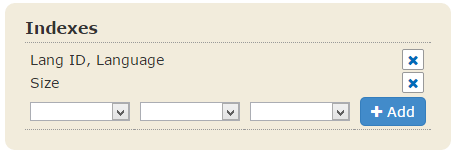What is indexing and what are advantages of using it
Perhaps you have already noticed, when you open a table all records in it are ordered by the date of modification. Correspondingly, the last one is the record that hasn’t been changed longer than the others. This is the default sorting, but you can sort your records by any column. Simply click the column title. If you want to order the table by this column in the reversed order, click it again.
If the number of records is fewer than 1000, sorting is pretty quick. However, if you have several thousands of records, you may experience a certain slowdown. Indexing provides sorting of records by a certain column or columns. If indexed, records are sorted much faster when you view them. Also, indexing significantly speeds up conditional filtering of records based on indexed fields.
You can manage indexing at the Table configuration page. Add records for every column you want to index. Simply specify a field name in the first list and click the Add button. If necessary, you can supply up to three columns in the same index. If you add a filed with the Text type to the index, this will speed up full text search and filtering of this column.

It is recommended to create indices you really need, as excessive indices lead to slower deleting, inserting and modifying of records. Besides, indices occupy disk space. If you want to delete an index, click the delete button in the right column of the active indices list.


